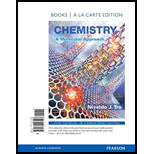
A chemical system produces 155 kJ of heat and does 22 kJ of work. What is ΔE for the surroundings?
a) 177 kJ
b) –177 kJ
c) 133 kJ
d) –133 kJ
To determine:
Answer to Problem 1SAQ
Solution: (a)
Explanation of Solution
Given info:
The amount of the heat produced = 155kJ.
The amount of the work done = 22kJ.
where q is the heat produced and w is the work done.
Thus,
Hence,
Want to see more full solutions like this?
Chapter 6 Solutions
Chemistry: A Molecular Approach, Books a la Carte Edition (4th Edition)
Additional Science Textbook Solutions
Introductory Chemistry (5th Edition) (Standalone Book)
General Chemistry: Atoms First
Chemistry: The Central Science (13th Edition)
Chemistry: An Introduction to General, Organic, and Biological Chemistry (13th Edition)
Chemistry: Structure and Properties
Organic Chemistry
- It takes 2260 J to vaporize a gram of liquid water to steam at its normal boiling point of 100C. What is H for this process?What is the work, given that the water vaporexpands against a pressure of 0.988atm? What is U for thisprocess?arrow_forwardWhat is the sign of the work when a refrigerator compresses a gas (the system) to a liquid during the refrigeration cycle?arrow_forwardThree gas-phase reactions were run in a constant-pressure piston apparatus as shown in the following illustration. For each reaction, give the balanced reaction and predict the sign of w (the work done) for the reaction. . If just the balanced reactions were given, how could you predict the sign of w for a reaction?arrow_forward
- When 1.000 g of ethylene glycol, C2H6O2, is burned at 25C and 1.00 atmosphere pressure, H2O(l) and CO2(g) are formed with the evolution of 19.18 kJ of heat. a Calculate the molar enthalpy of formation of ethylene glycol. (It will be necessary to use data from Appendix C.) b Gf of ethylene glycol is 322.5 kJ/mol. What is G for the combustion of 1 mol ethylene glycol? c What is S for the combustion of 1 mol ethylene glycol?arrow_forward2. Which of the following is true for a spontaneous process but not for a nonspontaneous process? Energy in the universe is concentrated conserved dispersed not conservedarrow_forwardDefine the following: a. spontaneous process b. entropy c. positional probability d. system e. surroundings f. universearrow_forward
- 9.20 State the first law of thermodynamics briefly in your own words.arrow_forwardCoal is used as a fuel in some electric-generating plants. Coal is a complex material, but for simplicity we may consider it to be a form of carbon. The energy that can be derived from a fuel is sometimes compared with the enthalpy of the combustion reaction: C(s)+O2(g)CO2(g) Calculate the standard enthalpy change for this reaction at 25C. Actually, only a fraction of the heat from this reaction is available to produce electric energy. In electric generating plants, this reaction is used to generate heat for a steam engine, which turns the generator. Basically the steam engine is a type of heat engine in which steam enters the engine at high temperature (Th), work is done, and the steam then exits at a lower temperature (Tl). The maximum fraction, f, of heat available to produce useful energy depends on the difference between these temperatures (expressed in kelvins), f = (Th Tl)/Th. What is the maximum heat energy available for useful work from the combustion of 1.00 mol of C(s) to CO2(g)? (Assume the value of H calculated at 25C for the heat obtained in the generator.) It is possible to consider more efficient ways to obtain useful energy from a fuel. For example, methane can be burned in a fuel cell to generate electricity directly. The maximum useful energy obtained in these cases is the maximum work, which equals the free-energy change. Calculate the standard free-energy change for the combustion of 1.00 mol of C(s) to CO2(g). Compare this value with the maximum obtained with the heat engine described here.arrow_forward
 Chemistry: The Molecular ScienceChemistryISBN:9781285199047Author:John W. Moore, Conrad L. StanitskiPublisher:Cengage Learning
Chemistry: The Molecular ScienceChemistryISBN:9781285199047Author:John W. Moore, Conrad L. StanitskiPublisher:Cengage Learning ChemistryChemistryISBN:9781305957404Author:Steven S. Zumdahl, Susan A. Zumdahl, Donald J. DeCostePublisher:Cengage Learning
ChemistryChemistryISBN:9781305957404Author:Steven S. Zumdahl, Susan A. Zumdahl, Donald J. DeCostePublisher:Cengage Learning
 Chemistry: An Atoms First ApproachChemistryISBN:9781305079243Author:Steven S. Zumdahl, Susan A. ZumdahlPublisher:Cengage Learning
Chemistry: An Atoms First ApproachChemistryISBN:9781305079243Author:Steven S. Zumdahl, Susan A. ZumdahlPublisher:Cengage Learning Chemistry: Principles and PracticeChemistryISBN:9780534420123Author:Daniel L. Reger, Scott R. Goode, David W. Ball, Edward MercerPublisher:Cengage Learning
Chemistry: Principles and PracticeChemistryISBN:9780534420123Author:Daniel L. Reger, Scott R. Goode, David W. Ball, Edward MercerPublisher:Cengage Learning Physical ChemistryChemistryISBN:9781133958437Author:Ball, David W. (david Warren), BAER, TomasPublisher:Wadsworth Cengage Learning,
Physical ChemistryChemistryISBN:9781133958437Author:Ball, David W. (david Warren), BAER, TomasPublisher:Wadsworth Cengage Learning,





